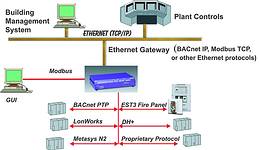
Building automation systems have been evolving over the past 25 years from the mixture of pneumatic controls, relays, sensors and actuators of the past to the direct digital controls of the present. Many manufacturers had developed their own protocol to enable their own devices to communicate with each other.
In many buildings interoperability sometimes would mean that the front-end controls for the various systems in the building all terminated in the same room. It was up to the facility manager to study each unique control system to learn what was going on in the building.
Communications challenges in building automation today are:
* Various systems in a building must communicate with each other or to a common control system.
* No common protocol in the industry.
* No single hardware supplier can provide devices for all factory functions.
* Real world is not a controller speaking only to a chain of slave devices.
* Data must be accessible at different points for different uses.
The various control systems in a plant or building can no longer afford to operate independently. Reduced manpower, increased energy costs, increased security needs and enhanced personnel demands means that the building systems must work together to provide the optimum environment for the people and equipment within the structure. For instance, in the case of a fire or smoke alarm, it might be important to know who had access to the area, what equipment is currently operating in the area, and whether or not safety systems are activated. If there are hazardous gases in the area, it would be prudent to know what gases are flowing and that they have been remotely shut off. Also, adjustment of the ventilation system in the affected area and the adjacent areas can reduce smoke damage costs. None of these ancillary features are mandatory features for the containment and suppression of the fire, but are important features in the operation and safety of the building.
Thus, there are many reasons for interoperability of building control systems, including:
* Reduced installation costs.
* Enhanced energy management.
* Improvement of safety and security of plant, personnel and equipment.
* Single-seat user interface.
How does the integrator get these various devices to be interoperable? It would be nice if all devices used a common communication protocol, but reality is that with the large number of legacy devices worldwide, plus the many different protocols available today, a single common protocol is not usually a choice. Also, for most devices there is usually only one protocol output available. A gateway system as illustrated in Figure 1 can seamlessly integrate systems together.

One such gateway that is widely used in the building automation industry is the EST Gateway. The basic idea of the Gateway is that it is a bridge between two or more different devices. These two devices can be using the same protocol or different protocols, or even different communication busses. As the data is fetched from a server node by the EST Gateway, it is stored in a data array at a specified location. The data is then accessible by a client node at any time.
The use of the EST Gateway means that all information available through a device communications port is now accessible by the building automation system. As an example, Figure 1, shows the wide range of information available from an EST3 fire panel from Edwards Systems Technology.
Interoperability is no longer a dream of the future, it is here today. While it is not simply plug and play, it will meet the integrator's need to share data between devices and enjoy unified control. Legacy systems do not need to be left out of an integrated Ethernet based system. Using gateways enables the integrator to bring in legacy devices and enable interoperability between diverse systems. The owner can select the system and device that meets their specific need and not worry about integration by using a gateway to link devices together.

© Technews Publishing (Pty) Ltd. | All Rights Reserved.